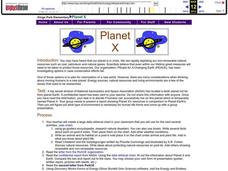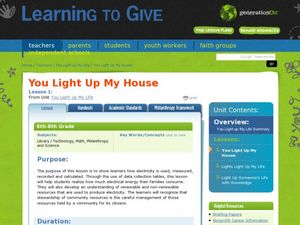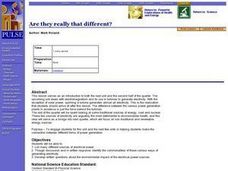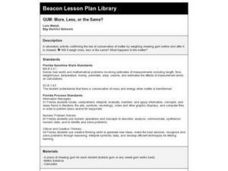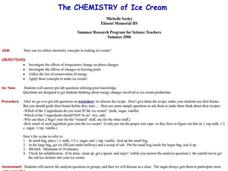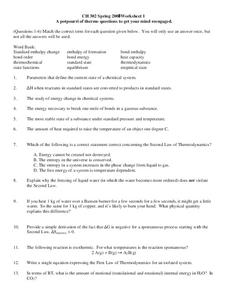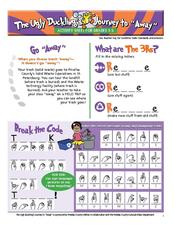Curated OER
Chemical Composition of American Coins
High schoolers investigate the chemical composition of pennies dated 1983 or later. In this chemical composition of American coins lesson plan, students scratch the surface of the penny to expose the zinc core. They put the penny in...
Curated OER
Efficiency
Fourth graders work cooperatively to investigate the efficiency of various household appliances. They share their findings in three to five minute oral presentations.
Curated OER
Planet X
Students select a wide variety of presentation methods to compare Planet X and Earth. Students share these with their classmates. Students select other methods to present their ideas about a livable planet for human life forms. ...
Curated OER
Warming by Freezing
Ninth graders discover the reasoning behind spraying water on fruit and seedlings in preparation for hard freezes. In this conceptual physics lesson, 9th graders conduct an experiment to measure the heat released when water goes from a...
Curated OER
Cell Wall Recipe: A Lesson on Biofuels
Biotech engineers discover that changes in the DNA code for cell wall formation can help create crops better suited for biofuel production. They extract DNA from wheat germ. They decode paper strips with codes and relate the activity to...
Curated OER
Energy Panel Hearings: "Your Town", Saskatchewan
Tenth graders access information to participate in a debate about whether a power plant should be placed in their town. They research an assigned point of view.
Curated OER
Momentum
Students learn the concepts of momentum and its conservation, using the recoil of a cannon as an example. They examine how momentum is a vector, allowing its conservation to be applied to problems in 2 and 3 dimensions.
Curated OER
You Light Up My House
Young scholars explore renewable and nonrenewable resources. In this electricity instructional activity, students consider way to reduce the energy that they use as they chart and analyze their own electricity usage.
Curated OER
Fossil Fuels--Discoveries and Uses
Student examine the close relationship between fossil energy and our daily lives. To demonstrate to the student the close relationship between fossil energy and our daily lives.
Curated OER
Resources
In this resources worksheet, students review renewable and nonrenewable resources. Students also review how resources can be conserved. This worksheet has 7 terms in a crossword puzzle, 3 true or false, and 10 short answer questions.
Curated OER
Connect the Species
Fourth graders, in pairs, explore energy transfer and species interrelationships by viewing slides on a microscope. hey explore phytoplankton (producers) and zooplankton (consumers)
Curated OER
Science: Generating Electricity
Eighth graders examine the various methods of generating electricity and explain their commonalities. They determine what is the most common source of energy and what are the potential environmental health hazards due to electrical...
Curated OER
GUM: More, Less, or the Same?
Young scholars confirm the law of conservation of matter by weighing chewing gum before and after it is chewed.
Curated OER
Earth Day
Students access a variety of Earth Day themed websites. They locate ideas to celebrate the holiday and examine how to protect the environment and conserve energy.
Curated OER
The Chemistry of Ice Cream
Students investigate the effects of temperature change on phase changes. They explore the effects of changes in freezing point and incorporate the law of conservation of energy. They utilize these concepts to make ice cream.
Curated OER
Hlf-Ball
Young scholars investigate Newton's Laws of Motion and the Law of Conservation of Energy. They examine how a ball and half-ball behave and relate these laws to what happens to the ball. Students produce a graph of the data collected...
Curated OER
Thermodynamics
In this thermodynamics worksheet, students review enthalpy, state functions, bond energy, and heat capacity. This worksheet has 2 multiple choice, 6 matching, and 12 problems to solve.
Curated OER
A Look at the Life That Electronics Lead
In this comprehension worksheet, learners fill in ways on a graphic organizer that people or companies can conserve energy, reduce waste or minimize the impact to the environment. Next, students solve 3 "environmental" math word problems.
Curated OER
Ice Ain't Easy
Students are introduced to the laws of thermodynamics. The 1st law of thermodynamics states that the energy must be conserved when two objects of different temperatures come in contact. If one object gains energy, the other object must...
Curated OER
Remote Sensing and the Electromagnetitc Spectrum
Fifth graders conclude that each color of the spectrum has a different amount of thermal energy by measuring temperature with a thermometer. They infer that there is an invisible band of the spectrum by measuring temperature beyond the...
Curated OER
The Importance and Future Of Canadian Resources
Ninth graders examine Canadian natural resources. In this geography skills lesson plan, 9th graders research answers to questions regarding Canada's water, energy, forests, and wildlife. Students use their findings to create posters that...
Curated OER
My Habitat Address
Sixth graders draw a habitat and write about what they would need to survive in the habitat. They define the input of items such as materials, energy, and information, and what goes out of the habitat. They play a "Habitat Address" game,...
Curated OER
A Tree Is More than a Street Name
Eighth graders discuss the role of trees as one of the most important natural resources. In groups, they examine how the forests nearby helped to shape their urban city. Using the internet, they research the use of the forest in early...
Curated OER
The Ugly Duckling's Journey to Away - Reduce, Reuse, and Recycle
In this recycling activity set, students read about where trash goes in Pinellas county. They fill in blanks in the words reduce, recycle, and reuse. They identify items that can be recycled, make words from the letters in the word...




